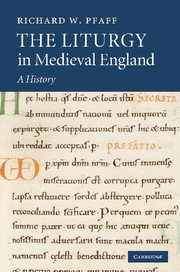Book contents
- Frontmatter
- Contents
- Preface
- Sigla and editorial conventions
- Bibliographical abbreviations
- Nicknames for manuscripts frequently referred to
- 1 Introduction
- Excursus: on sources
- 2 Early Anglo-Saxon England: a partly traceable story
- Excursus: on the terms Gregorian and Gelasian as used here
- 3 Later Anglo-Saxon: liturgy for England
- 4 The Norman Conquest: cross fertilizations
- Excursus: on method in the comparison of liturgical texts
- 5 Monastic liturgy, 1100–1215
- Excursus: on ascription of liturgical books to specific churches
- 6 Benedictine liturgy after 1215
- 7 Other monastic orders
- 8 The non-monastic religious orders: canons regular
- 9 The non-monastic religious orders: friars
- Excursus: on liturgical books from female religious houses
- 10 Old Sarum: the beginnings of Sarum Use
- 11 New Sarum and the spread of Sarum Use
- 12 Exeter: the fullness of secular liturgy
- 13 Southern England: final Sarum Use
- 14 Regional Uses and local variety
- 15 Towards the end of the story
- Index of Manuscripts
- Index of Saints
- General Index
5 - Monastic liturgy, 1100–1215
Published online by Cambridge University Press: 20 March 2010
- Frontmatter
- Contents
- Preface
- Sigla and editorial conventions
- Bibliographical abbreviations
- Nicknames for manuscripts frequently referred to
- 1 Introduction
- Excursus: on sources
- 2 Early Anglo-Saxon England: a partly traceable story
- Excursus: on the terms Gregorian and Gelasian as used here
- 3 Later Anglo-Saxon: liturgy for England
- 4 The Norman Conquest: cross fertilizations
- Excursus: on method in the comparison of liturgical texts
- 5 Monastic liturgy, 1100–1215
- Excursus: on ascription of liturgical books to specific churches
- 6 Benedictine liturgy after 1215
- 7 Other monastic orders
- 8 The non-monastic religious orders: canons regular
- 9 The non-monastic religious orders: friars
- Excursus: on liturgical books from female religious houses
- 10 Old Sarum: the beginnings of Sarum Use
- 11 New Sarum and the spread of Sarum Use
- 12 Exeter: the fullness of secular liturgy
- 13 Southern England: final Sarum Use
- 14 Regional Uses and local variety
- 15 Towards the end of the story
- Index of Manuscripts
- Index of Saints
- General Index
Summary
The “long twelfth century” covered by this chapter is marked by date-limits that are not entirely perfunctory. By 1100 the Constitutions of Lanfranc (who died in 1089) had, as we saw in chapter 4, been disseminated to, at least, the monastic establishments at Durham, St Albans, Canterbury St Augustine's, and probably Rochester, Westminster, and a number of other places as well. But they were by no means prescriptive and did not form anything like a common customary for all Benedictine houses in England. Individual houses exercised varying degrees of liturgical independence, within a common framework (much of it shared, of course, by secular churches). This independence is, at least in theory, limited in 1215, when the program of Innocent III, expressed above all in the canons of the Fourth Lateran Council which met in that year, brought about the emergence of what can fairly be called the Benedictine order. (That said, the present chapter is concerned with “mainstream” Benedictine establishments only; the liturgies of other groups of more-or-less Benedictine monks – Cluniacs, Cistercians, and Carthusians – will be dealt with separately.)
Documentation for the study of the present subject is plentiful but irregular, as the example of just three monasteries shows. For one major house, St Albans, we have not only a number of surviving service books but also a rich historical tradition stretching from the work of Roger of Wendover and Matthew Paris in the thirteenth century to the fifteenth-century chronicles of Thomas Walsingham and John Whethamstede. For another, Glastonbury, evidence from service books survives only in fragmentary leaves from a collectar (now in the library of Wells cathedral, with no shelf number; p. 179 below).
- Type
- Chapter
- Information
- The Liturgy in Medieval EnglandA History, pp. 157 - 191Publisher: Cambridge University PressPrint publication year: 2009



